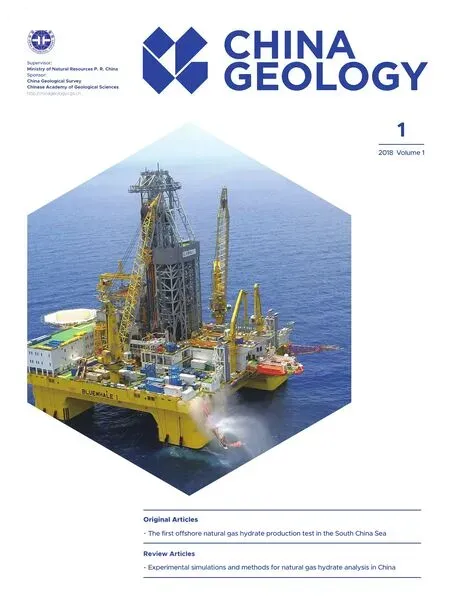New prospecting progress using information and big data of coal and oil exploration holes on sandstone-type uranium deposit in North China
Ruo-shi Jin, Pei-sen Miao, Xian-zhang Sima, Reng-An Yu, Yin-hang Cheng, Chao Tang, Tianfu Zhang, Cong Ao, Xue-ming Teng
a Tianjin Center, China Geological Survey, Tianjin 300170, China
b Laboratory of Non-fossil Energy Minerals, Tianjin Center of China Geological Survey, Tianjin 300170, China
1. Objective
A series of Mesozoic-Cenozoic continental sedimentary basins exist in North China, coexisting with coal, oil/gas, and salt resources. Many previous drilling projects have been conducted within these basins to explore coal, petroleum, and mineral resources, however, these data have not been integrated due to different industries owners. In order to efficiently explore the large-sized, easily extracted, and environmentally friendly, sandstone-type uranium deposits, previous coal and oil exploration drilling-hole data are systematically collected,processed, and analyzed to improve the sandstone-type uranium prospecting exploitation. At the same time, we also discussed the uranium source, ore-forming process and model for the sandstone-type uranium deposits.
2. Methods
Total 221357 coal and oil exploration holes are selected from 854 coal and oil exploration areas in nine basins (including the Junggar Basin, Ordos Basin, and Songliao Basin, etc.).Based on the analysis of these radioactive logging curves,classification criteria for barren holes, abnormal holes, and potential industrial holes are established, and a series of prospecting methods and technical codes for “exploring coal–uranium and oil–uranium” in sandstone-type uranium deposits are formulated. Then we use these indexes to guide uranium mineralization prospecting.
3. Results
By reutilizing these 221357 coal and oil exploration well data, 12028 uranium abnormal holes and 5147 potential uranium industrial holes are recognized, and 122 mineralization prospects and 300 prospecting targets are delineated. 150 uranium ore holes and 183 mineralization holes are analyzed with ore intersection rates up to 40%. Four potential largesized deposits, 11 mid-small mineral sites, 35 ore occurrences,and 73 mineralized spots have been discovered.
A drilling database is established for uranium deposits within main uranium-bearing basins, such as Yili, Junggar,Er'lian, Ordos, and Northern Songliao Basins. The database is enabled to help better understand the paleo-sedimentary and evolutionary characteristics of uranium mineralization formation in a basin scale, and time-space variable relations during the mineralization, and the relationship between ore clusters(rather than a deposit) and controlling factorscaused by structures (Fig. 1).
The Mesozoic uranium-bearing basins in China are classified. The idea that"a large basin, large amount of sand, and large-scale mineralization result in large deposits" is proposed to help transform the exploration and prospecting focus from narrow, elongated, basins to open large-sized basins. Ore prospecting breakthroughs have been made in Junggar, Ordos,and Songliao Basins.
Massive well-tie sections of drill holes were compiled,which is determined that uranium-bearing rocks within north China basins mostly display vertical zoning (Fig. 1). The concept of a stratigraphic sequence is proposed with a uranium-bearing rock series model and red-black coupling. The red-black vertically sequential zoning represents the depositional environment change from oxidizing to reducing environment which provides "obstacle" and "field" for mineralization respectively.

Fig. 1. 3D model shows interbedded sandstone bodies from Zaohuohao uranium deposit.
On the basis of structural conditions and sedimentary environments of the U-bearing rock series, three structural styles of sandstone-type uranium deposits in China can be recognized, river valley style, basin marginal style, and intrabasin uplifted marginal style. The differences between the margin and center of a basin are the sedimentary facies and the distance from the uranium source.The U-bearing rock series of basin marginal type are often developed in monoclinic structure whereas the series of the intrabasin uplifted marginal type are usually formed in anticline or the edge of dome.
4. Conclusions
The compilation of big data analysis of historical drill holes is able to delineate prospecting targets and discovery of mineral producing sites, thereby reducing the amount of time and funds involved in ore prospecting.
The database corrects the concept of "point replacing surface to inference", which is inherent in original prospecting theories and metallogenic models but incompatible with objective facts. The database also provides foundations for research on sandstone-type uranium metallogenesis within the Mesozoic-Cenozoic continental basins in North China.
The proposed uplifted marginal structural style within a basin challenges the traditional belief that "mineralization was hardly present and utilized inside a basin" and is of great significance when selecting target areas for exploration.
The proposed "coupling of red-black rock series" reveals the paleo-environmental conditions related to the formation of sandstone-type uranium deposits.
Acknowledgement
This paper was supported by the National Basic Research and Development Program of China (2015CB453000) and China Geological Survey Projects (DD20160127, DD2016 0128).
- China Geology的其它文章
- Three source rocks discovered in the Mid-Lower Jurassic, Dunhuang Basin in China
- Metamorphic petrology and geology in China: A review
- The oldest shale gas reservoirs in southern margin of Huangling uplift, Yichang,Hubei, China
- A discovery of Silurian tight shale gas in Jianshi, Hubei, China
- Some progress on understanding the Phanerozoic granitoids in China
- A super-large graphite deposit discovered in granite rocks at Huangyangshan,Xinjiang, China

